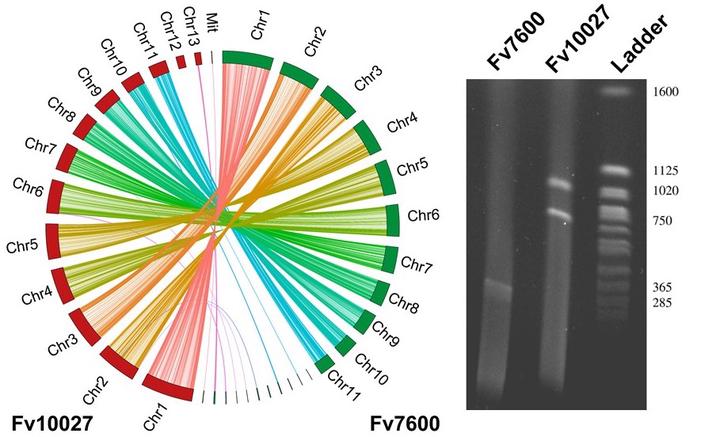Role of dispensable chromosomes in Fusarium verticilloides

The maize pathogen Fusarium verticillioides causes huge economic losses per year due to the production of fumonisins. Fusarium verticillioides ITEM 10027 (Fv10027) isolated in Italy shows a reduced fumonisins synthesis when compared to the F. verticillioides reference strain 7600 (Fv7600). Although the difference in fumonisins production, the pathogenicity tests on maize stalk did not show any difference in infection levels. Additionally, using knock-out mutant in FUM1 gene did not show any compromised virulence in stalk rot assay. To better understand Fv virulence, the genome of Fv10027 was sequenced and assembled. Comparative genomics between Fv7600 and Fv10027 showed a difference in genome size of about 1.4 Mb despite 99% nucleotide identity. Genome assembly of Fv10027 showed that two mini-chromosomes of about 1 Mb and 750 Kb were unique to Fv10027 while a mini-chromosome of about 400Kb to Fv7600. To determine the presence of these mini chromosomes in the Italian Fv population, 24 strains, sampled in the Po valley, were sequenced; presence/absence analysis showed that only three Fv strains had those chromosomes. The analysis of Fv10027 dispensable chromosomes showed an enrichment of secreted proteins and a higher level of repetitive elements. Intriguingly, BLAST analysis on the Fv10027 proteome showed that proteins codified on mini chromosomes have the best identity to F. oxysporum proteins located at dispensable chr3 and chr6. Moreover, synonyms substitution analysis suggests that mini chromosomes of F. verticilloides were not probably acquired through a horizontal chromosomal transfer from F. oxysporum but rather originated before the split of the two species.
The aim connect to this project are multiple:
- Understand the role of mini-chromosomes in the interaction with Maize
- Understand the role on mycotoxins in the interaction with the host
- figure out which are the molecular shift that make the pathogen necrotrophic after a biotrophic phase